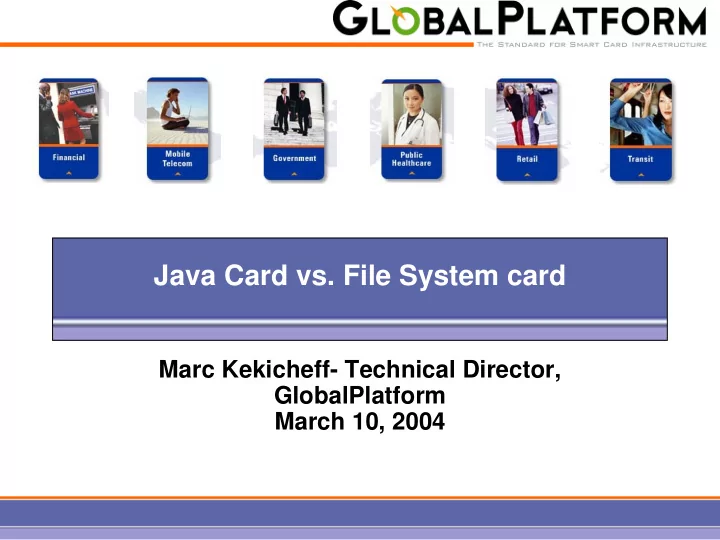

Java Card vs. File System card Marc Kekicheff- Technical Director, GlobalPlatform March 10, 2004
A misleading question ? � File System = a data structure seen at the card edge “This part of ISO/IEC 7816 specifies: the contents of the messages, commands and response pairs transmitted by the interface device to the card and conversely, the structure of files and data in the card as seen at the interface when processing interindustry commands for interchange, access methods to files and data in the card, a security architecture defining access rights to files and data in the card... It does not cover the internal implementation within the card and / or the outside world.” First lines of the scope of ISO/IEC 7816-4:1995 � Java Card = a programming language and API for applications “Java Card technology combines a portion of the Java programming language with a runtime environment optimized for smart cards and related, small-memory embedded devices. The goal of Java Card technology is to bring many of the benefits of Java software programming to the resource-constrained world of smart cards.” First lines of the Java Card specifications preface � Two different dimensions… …that are not contradictory � ISO 7816 parts 4 & 5 define application naming and selection � SCP TS 102.241 defines a Java Card API for file system access
An obsolete debate ? � Brief history: � Late 80’s: B0, a mono-application card with flat memory space (direct absolute addressing) � Early 90’s: SIM, a mono-application card with a unique hierarchical file structure (select by file id along a path) � Mid-90’s: EMV, a mono-application card with a non-unique file structure (select by AID, one or more instances) � Late 90’s: Java Card, a multi-application card without a file structure (select by AID); SIMToolKit, multi applications on top of a SIM card � Standards: � ISO 7816-4:1995 defines a unique hierarchical file structure � Java Card defines a non-hierarchical multi-application environment � Current revision of ISO 7816-4 introduces a non-hierarchical multi- application file structure � The smart card is more than a (secured) floppy disk…
A legacy issue ? � The smart card is a micro-processor… …but what is a smart card application? � No ISO 7816 definition: only application file structure (ADF) � Naïve definition = code � Full definition = code + data set / instance � Legacy OS mirror internally the ISO 7816 file system card edge � Consequence #1: everything must go into a file: “free” tagged data, PINs, secret keys, etc… � Consequence #2: no application code independent of OS � Java Card = the 1 st standard that defines applications independent of OS (incl. API, firewall, etc.) � Consequence: no predefined file & data structures, total flexibility � GlobalPlatform = the 1 st standard that defines card & application management (incl. separate lifecycle, security rules, etc.) � Standardized management independent of OS, Java Card…
The Smart Card System Paradigm � The smart card is the thinnest personal computer… …integrated in an IT infrastructure � The smart card system infrastructure must manage � Distributed software among all system components Plus � Hardware: the smart card itself And � Security (distributed over the entire system) And � Customization (a card is highly personal) � A nice IT management challenge… …addressed by GSC-IS (data management & transaction) …and GlobalPlatform (card & application management)
Recommend
More recommend